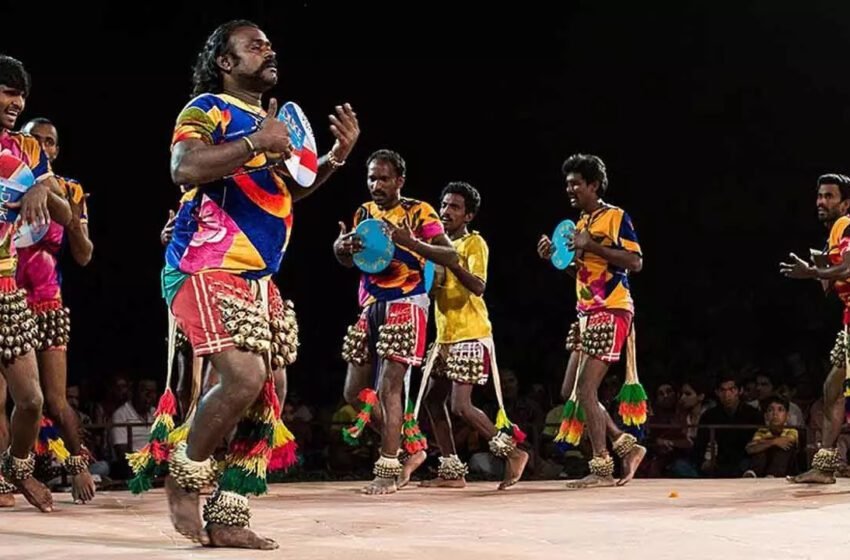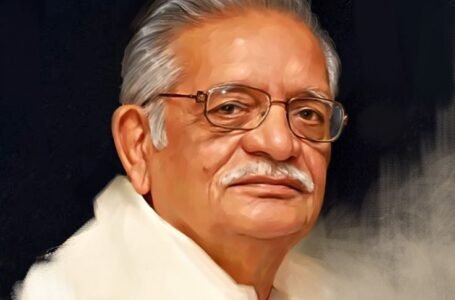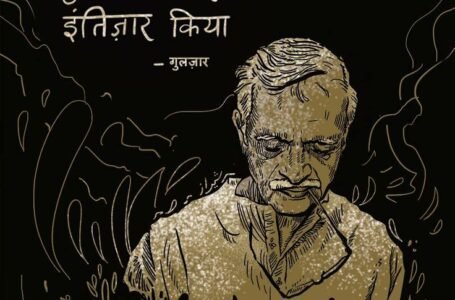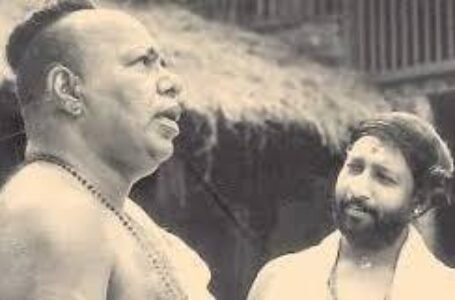Tappeta Gullu: The Rhythmic Dance of Andhra Pradesh – A Celebration of Devotion and Tradition
- Ancient history Asian history
 Jayshree Waghela
Jayshree Waghela- February 24, 2025
- 0
- 13

Tappeta Gullu is a vibrant and energetic folk dance native to the coastal regions of Andhra Pradesh, particularly in the northern districts such as Srikakulam, Visakhapatnam, and Vizianagaram. This dynamic dance form, deeply rooted in local religious practices and community life, is traditionally performed to invoke blessings from the rain goddess Gangamma and to celebrate the agricultural cycle.
The dance derives its name from the Tappeta, a flat drum that plays a central role in the performance. Historically, it was practiced by Yadava shepherds to seek divine intervention for a bountiful harvest. Over time, Tappeta Gullu transcended its ritualistic origins and became a popular form of celebratory entertainment, performed during festivals, marriages, and other significant social events. Despite its rich cultural heritage and mesmerizing display of physical prowess, Tappeta Gullu is now a vanishing art form, as modernization and changing lifestyles have reduced its prevalence.
Historical and Cultural Origins of Tappeta Gullu
Tappeta Gullu traces its origins to ancient agrarian societies where communities were closely connected to the rhythms of nature. In earlier times, rural Andhra Pradesh heavily relied on rain for successful crop cycles, making Gangamma, the goddess of rain and fertility, a central deity in their worship practices. This dance emerged as a ritualistic offering to please the goddess and ensure seasonal rains for a successful harvest.
The Yadava community, primarily shepherds and cattle-herders, were the first to perform Tappeta Gullu. For them, the dance was not just a cultural expression but also a spiritual practice deeply intertwined with their agricultural livelihood. During periods of drought or uncertainty, the community would organize Tappeta Gullu performances, believing that their rhythmic devotion would appease the rain goddess and bring forth rainfall.
Over time, the dance became more than a simple act of worship. It transformed into a celebratory event where mythological stories, especially from the Ramayana, Bhagavata Purana, and the ten incarnations of Lord Vishnu (Dashavatara), were enacted through the performance. The fusion of storytelling, music, and rhythmic movement added a theatrical dimension to the dance, attracting audiences from across the region.
The Ritualistic Performance of Tappeta Gullu
A traditional Tappeta Gullu performance is a grand spectacle that involves an entire village. The ritual begins with a procession, where a decorated water pot, symbolizing the rain goddess Gangamma, is carried through the village. This ritual serves both as an act of reverence and a public invitation to witness the dance.
The main performance takes place in the evening, when the community gathers to watch the dancers. The group typically consists of 12 to 20 male performers, reflecting the dance’s demanding physical nature. The men wear vibrant dhotis and shirts, adorned with ankle bells (ghungroos) that create a rhythmic accompaniment to their movements. Each dancer also carries a Tappeta drum, securely tied to their chest, which they play while executing intricate footwork.
The performance is characterized by high-energy movements, synchronized drumming, and acrobatic feats that require immense stamina and discipline. The dancers perform in circular formations, symbolizing cosmic cycles and the unity of the community. The rhythm of the drums intensifies as the performance progresses, creating a hypnotic atmosphere that captivates the audience.
The themes of the performance often draw from Hindu mythology, depicting epic tales like the Ramayana and the Bhagavata Purana. One of the most compelling segments involves the portrayal of Dashavatara, the ten incarnations of Lord Vishnu. Each avatar is represented through symbolic gestures and rhythmic sequences, blending religious devotion with artistic expression.
Gangamma Jatara: The Festival of Rain and Renewal
The Gangamma Jatara (Jathra) is the most significant occasion for Tappeta Gullu performances. This eight-day festival, celebrated at the beginning of the fishing season, is a major cultural event in coastal Andhra Pradesh and parts of Karnataka. It begins on Bhishma Ekadashi, an auspicious day in the Hindu calendar.
During the festival, the entire village participates in elaborate rituals, culminating in the Tappeta Gullu dance. The festival symbolizes the community’s collective hope for rain, prosperity, and protection from natural disasters. The dance is believed to invoke the goddess’s blessings and ensure a fruitful agricultural cycle.
The procession of the water pot, the vibrant costumes, and the pulsating drumbeats create an electrifying ambiance. The festival also serves as a platform for cultural exchange, as people from neighboring villages and even distant regions come to witness and participate in the celebrations.
The Skill and Stamina Behind Tappeta Gullu
Performing Tappeta Gullu requires extraordinary physical endurance and skill. The repetitive drumming, vigorous footwork, and acrobatic movements place immense strain on the dancers. Training for the dance begins at a young age, with experienced performers mentoring novices in the intricate techniques.
The dancers must master:
- Rhythmic Precision – Maintaining perfect synchronization with the drumbeats and fellow dancers.
- Physical Stamina – Sustaining high-energy movements for extended periods without losing intensity.
- Acrobatic Prowess – Incorporating flips, jumps, and dynamic spins into the performance.
- Musical Sensitivity – Harmonizing their drumming with the accompanying instruments, such as the dhol and mridangam.
Due to its demanding nature, Tappeta Gullu is traditionally performed only by men, although modern adaptations have seen limited participation by women.
Costumes and Instruments: A Visual and Auditory Delight
The costume worn by Tappeta Gullu performers is simple yet striking. It consists of a vibrantly colored dhoti and shirt, chosen to enhance visibility during performances. Ankle bells (ghungroos) are essential, as their rhythmic jingling adds a distinctive auditory layer to the performance.
The defining feature Is the Tappeta drum, a flat, circular percussion instrument tied to the chest. This design allows the dancers to play the drum while maintaining freedom of movement. The sound of the drum, combined with the jingling of the bells, creates a mesmerizing soundscape that is both celebratory and spiritual.
The Decline and Preservation of Tappeta Gullu
Despite its cultural significance, Tappeta Gullu is a fading tradition. Several factors contribute to its decline:
- Urbanization and Modern Lifestyles – As younger generations migrate to cities, they lose touch with rural cultural practices.
- Economic Pressures – Traditional performers struggle to sustain themselves financially, as there is limited patronage for folk arts.
- Changing Agricultural Practices – Mechanized farming and climate change have reduced the reliance on rain rituals, diminishing the spiritual motivation behind Tappeta Gullu.
- Lack of Institutional Support – There are few formal programs dedicated to preserving and promoting this unique dance form.
Efforts to revive Tappeta Gullu include organizing cultural festivals, documenting performances, and incorporating it into school curricula. Cultural organizations and local governments are also working to provide financial incentives to keep the tradition alive.
Conclusion
Tappeta Gullu is more than just a dance—it is a living testament to the cultural heritage, spiritual devotion, and artistic brilliance of Andhra Pradesh. Its pulsating rhythms, acrobatic movements, and mythological storytelling create a unique cultural experience that resonates with audiences across generations.
While modernity threatens its survival, renewed efforts in documentation, education, and performance offer hope for its preservation. By cherishing and supporting Tappeta Gullu, we ensure that this vibrant expression of faith and community continues to echo through the generations, celebrating the timeless bond between humanity and the divine.


